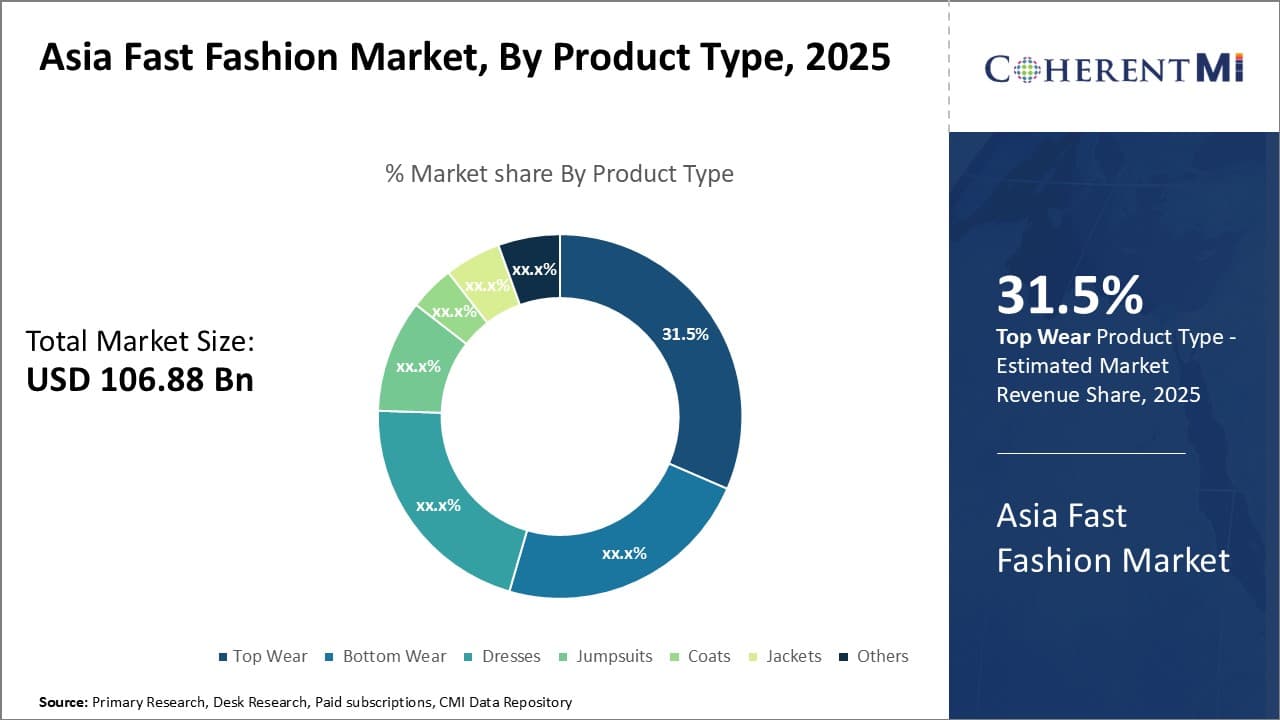

The Asia fast fashion market is estimated to be valued at US$ 106.88 Bn in 2025 and is expected to reach US$ 183.17 Bn by 2032, growing at a compound annual growth rate (CAGR) of 8.0% from 2025 to 2032. Fast fashion refers to inexpensive and trendy clothing that moves quickly from the catwalk to the stores to capture the latest trends. The fast fashion model relies on rapid turnover of styles and high volume sales at relatively lower profit margins per item. The fast fashion market has boomed in Asia, driven by rising disposable incomes, increasing middle-class population, growing youth demographics, and the proliferation of social media.
The Asia fast fashion market is segmented by product type, end user, price range, age group, distribution channel, and region. By product type, the top wear segment accounted for the largest market share in 2025. The rising demand for stylish and affordable tops and t-shirts among young consumers is driving the growth of the top wear segment in the Asia fast fashion market.
Asia Fast Fashion Market Drivers:
Asia Fast Fashion Market Opportunities:
Asia Fast Fashion Market Restraints:
Analyst Viewpoint
The Asia fast fashion market continues to see strong growth driven by rising disposable incomes and adoption of Western-influenced fashion trends among Millennials. The majority of the demand comes from population heavyweights like China and India where the appetite for affordable trendy clothes has drastically increased. Southeast Asian countries have also emerged as bright prospects backed by their growing middle class and affinity towards instant gratification culture epitomized by fast fashion.
However, market expansion can face challenges from increasing raw material costs and volatile cotton prices that may pinch margins for retailers. Additionally, strengthening local manufacturing in certain countries poses a threat to dominant low-cost hubs like Bangladesh and Cambodia. Sustainable practices still need more focus as the fast turnover of collections increases textile waste production in Asia.
On the opportunities side, online channels present a large untapped avenue considering digital growth rates in the region. Livestreaming and social commerce are letting brands forge closer connections with younger shoppers beyond metro markets. Collaborations with popular regional influencers and celebrities can further fuel discovery for international labels.
Going forward, Southeast Asia is predicted to outpace others on the back of continued economic development and the rising spending power of digitally-savvy populations. Vietnam, the Philippines, and Indonesia specifically stand out as high-potential growth drivers for fast fashion companies looking to diversify operations beyond dominant China. Overall, the Asia market remains one of the brightest prospects.
Market Size in USD Bn
CAGR8.0%
| Study Period | 2025-2032 |
| Base Year of Estimation | 2024 |
| CAGR | 8.0% |
| Larget Market | Asia |
| Market Concentration | High |
| Major Players | Uniqlo, H & M, Zara, Mango, Forever 21 and Among Others |
 To learn more about this report, Download Free Sample Copy
To learn more about this report, Download Free Sample CopyThe Asia Fast Fashion Market is competitive and consists of some players in the market such as New Look, River Island, Matalan, Vero Moda, Only, Jack & Jones, Stradivarius, Bershka, Pull & Bear, Uniqlo, H&M, Zara, Mango, Forever 21, Topshop, Marks & Spencer, GAP, C&A, Benetton, Esprit
New product launches
Acquisition and partnerships
Would you like to explore the option of buying individual sections of this report?
Sakshi Suryawanshi is a Research Consultant with 6 years of extensive experience in market research and consulting. She is proficient in market estimation, competitive analysis, and patent analysis. Sakshi excels in identifying market trends and evaluating competitive landscapes to provide actionable insights that drive strategic decision-making. Her expertise helps businesses navigate complex market dynamics and achieve their objectives effectively.
Asia Fast Fashion Market is Segmented By Product Type (Top Wear, Bottom Wear, Dresses, Jumpsuits, Co...
Asia Fast Fashion Market
How big is the Asia Fast Fashion Market?
The Asia Fast Fashion Market is estimated to be valued at USD 106.9 in 2025 and is expected to reach USD 183.2 Billion by 2032.
What are the major factors driving the Asia fast fashion market growth?
Rising disposable incomes, increasing youth population, growing e-commerce, penetration of social media, and demand for the latest fashion trends are factors that hamper the market
Which is the leading product segment in the Asia fast fashion market?
The top wear segment is the leading component in the Asia fast fashion market owing to the high demand for stylish and affordable tops and t-shirts.
Which are the major players operating in the Asia fast fashion market?
Major players include Uniqlo, H&M, Zara, Mango, Forever 21, Topshop, Marks & Spencer, GAP, and C&A among others.
Which region will lead the Asia fast fashion market?
The market is projected to grow at a CAGR of 8.0% from 2025 to 2032.